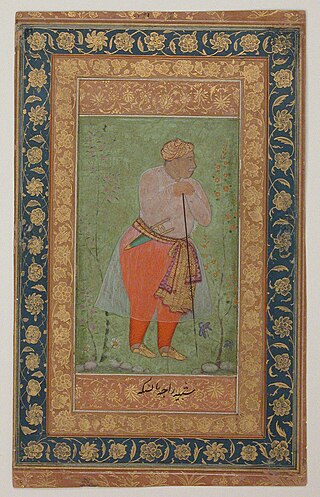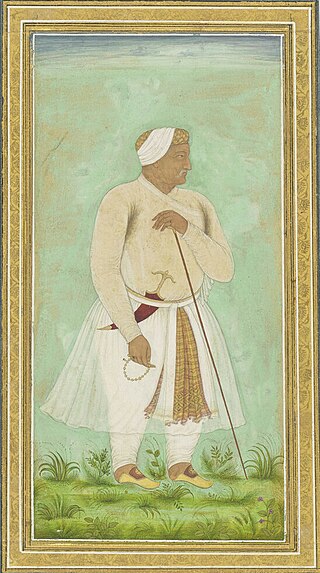
Amber or Amer, is a city near Jaipur in Jaipur district in the Indian state of Rajasthan. It is now a part of the Jaipur Municipal Corporation.

Sawai Jai Singh II, was the 29th Kachwaha Rajput ruler of the Kingdom of Amber, who later founded the fortified city of Jaipur and made it his capital. He became the ruler of Amber at the age of 11, after the death of his father, Mirza Raja Bishan Singh, on 31 December 1699.

The Kachhwaha, or Kachhawa is a Rajput clan found primarily in India.

Dhundhar, also known as Jaipur region, is a historical region of Rajasthan state in western India. It includes the districts of Jaipur, Neem ka Thana, Dantaramgarh part of Sikar District lying to the east of the Aravalli Range, Dausa, Sawai Madhopur, Tonk, southern part of Kotputli and the northern part of Karauli District.

Mirza RajaMan Singh I was the 24th Maharaja of Amber from 1589 to 1614. He also served as the Subahdar of Bengal for three terms from 1595 to 1606 and the Subahdar of Kabul from 1585 to 1586. He served in the Imperial Mughal Army under Emperor Akbar. Man Singh fought sixty-seven important battles in Kabul, Balkh, Bukhara, Bengal and Central and Southern India. He was well versed in the battle tactics of both the Rajputs as well as the Mughals. He is commonly considered to be one of the Navaratnas, or the nine (nava) gems (ratna) of the royal court of Akbar.

The Kingdom of Amber, also known as Kingdom of Dhundhar, and Jaipur State, was located in the north-eastern historic Dhundhar region of Rajputana and was ruled by the Kachwaha Rajput clan. It was established by Dulha Rai, possibly the last ruler of the Kachchhapaghata dynasty of Gwalior who migrated to Dausa and started his kingdom there with the support of Chahamanas of Shakambhari in the 12th century. Mostly through 12th to 15th century, the kingdom faced stagnation, sources were scarce. Under its ruler, Raja Chandrasen Amer became a Sisodia vassal and fought in the Battle of Khanwa under Raja Prithviraj Kachhwaha.

Raja Bhagwant Das was the 23rd Kachwaha Rajput ruler of Kingdom of Amber.He also served as the imperial Subahdar of Lahore and Kabul for a few months in 1586. His sister Harka Deiji later known as "Mariam-uz-Zamani", was the chief consort of Mughal Emperor Akbar. His son Man Singh I, one of the Navaratnas of Akbar became the highest-ranking official of his court and his daughter,Manbhawat Deiji or Man Bai, was the first and chief consort of Prince Salim.
Pajawan or Pajjun was the 5th Kachhwaha ruler of the Kingdom of Amber. He belonged to the Kachhwaha Rajput clan who had migrated to Rajputana in the 12th century. He was married to Prithviraj Chauhan's cousin and was a prominent and trusted general of Prithviraj. Pajwan fought 64 important battles in his military career.
Raja Askaran was a late sixteenth-century Kachwaha Rajput ruler. Though briefly Raja of Amber, for the majority of his life Askaran was the ruler of Narwar. He along with his sons and grandsons also had a distinguished career as military officers and noblemen under Mughal Emperor Akbar and rose high in his service. He was also the maternal grandfather of Manavati Bai of Marwar consort of Emperor Jahangir and mother of Emperor Shah Jahan,hence maternal great grandfather of Shahjahan.
The Mughal–Rajput wars were a series of battles between the Rajput Confederacy and the Mughal Empire. The conflicts originated with the invasion of northwestern India by the Mughal ruler Babur, to which the head of the Rajput confederacy, Rana Sanga, offered staunch resistance.
The history of human settlement in the west Indian state of Rajasthan dates back to about 5,000 years ago.
Jhotwara is a suburban area of Jaipur in the north-west direction of Jaipur, the capital of Indian State of Rajasthan. It is a Legislative Assembly constituency
The Badgujar / Bargujar / Badgurjar is a clan of Rajputs. They are also a distinct caste in Maharashtra.
The Battle of Bagru was a military engagement fought between multiple Indian kingdoms in 1748 near the town of Bagru, Jaipur, India. The battle was fought during a succession crisis following the death of Jai Singh II, which left Jaipur without effective Madho Singh defeated ishwari Singh in a 6 day with help of Marathas and kingdom of bundi.
Raja Prithviraj Singh I, also known as Prithvi Singh I, was the 16th-century Kachwaha Rajput ruler of Kingdom of Amber. He was a monarch of strong religious inclinations and during his reign, the Kingdom of Amber became increasingly politically active. He took part in the Rajput alliance against Mughal Emperor Babur, fighting against the latter in the Battle of Khanwa alongside Rana Sanga of Mewar in the year 1527. Three of Raja Prithviraj's sons successively followed him as ruler of Amber, with many of his descendants also populating the kingdom's highest aristocracy in subsequent centuries.
Raja Puranmal was a sixteenth-century ruler of Amber.He succeeded his father Raja Prithviraj to the throne of Kachwahas of Kingdom of Amber in 1527.
Khoh, also known as Khogong, was the capital of the kingdom of Amber which was located in the Dhundhar region of Rajputana. Which was located just five miles to the east of Jaipur city and was ruled by the Chanda clan. Rao Chandrasen Chanda abandoned Mahishmati city and established a kingdom here. It was the capital of the Chandas till the 11th century and of the Kachhawahas from the 11th to the 13th century.
Susawat or Susaot is the name of a historical Meena clan during medieval India. They ruled over the historical region of India called Amber.
Dulha Rai was the founder of the Kachhwaha dynasty and also the 1st king from this dynasty who ruled the territory of Dhundhar, with his capital at Khoh in present-day Rajasthan. He started his rule from Dausa which he obtained as a dowry from the Chahamanas of Shakambhari. Making Dausa as his base, he started conquering the region of Dhundhar and soon was recognised as the ruler of this region by the Chahamanas after he successfully suppressed the rebellious Bargujar Rajputs.






